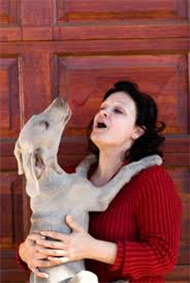Service Animals Make Our Lives So Much Easier
 WE’VE ALL ENCOUNTERED SERVICE ANIMALS–THE DOGS, CATS AND horses trained to help those with disabilities accomplish the myriad tasks of daily life. Certainly we know the all-stars: the handsome Seeing Eye dog, its skill and dedication shining through as it guides its master or mistress along a busy city street, stopping at traffic lights, negotiating sidewalks, curbs and crowds of people.
WE’VE ALL ENCOUNTERED SERVICE ANIMALS–THE DOGS, CATS AND horses trained to help those with disabilities accomplish the myriad tasks of daily life. Certainly we know the all-stars: the handsome Seeing Eye dog, its skill and dedication shining through as it guides its master or mistress along a busy city street, stopping at traffic lights, negotiating sidewalks, curbs and crowds of people.
Most of us are also aware of the dog’s less famous service brethren–the hearing dogs who alert hearing-impaired people to telephone rings, smoke alarms or babies’ cries; the specially trained dogs, cats, birds and rabbits that visit people in long-term care homes and help alleviate their loneliness and depression; even the horses that help disabled children and adults gain vital strength and coordination as well as new confidence through therapeutic riding programs across the country. According to the Delta Society, a Renton, Washington-based group dedicated to fostering the partnership between humans and service animals, these animals are legion–numbering some 16,000 and growing.
Even better news is emerging for those with disabilities, says Lynnette Spanola, Delta Society vice-president of development and public relations. Entirely new types of service animals are coming to the fore. Not only are they expanding the repertoire of animal skills, they’re bringing new help–and new hope–to some for whom assistance from service animals was never before possible.
GOOD DOGS The nonprofit organization Canine Companions for Independence (CCI) has pioneered the training of service dogs to perform all kinds of tasks for disabled people. The dogs can open and close doors, turn lights on and off, fetch or carry objects and pull wheelchairs. But that’s not all. “Now, for people with epilepsy or other seizure disorders, there are seizure-alert dogs,” Spanola says. “They can give their owners a warning anywhere from three to thirty minutes ahead of an attack, allowing them to get to a safe place and prepare for it. We’re not quite sure how the animal knows; it might sense a change in the owner’s smell or energy level.” For Donna Jacobs, who became subject to seizures following a stroke, and whose dog Patra won the Delta Society’s Top Dog award last year, “having a seizure dog made the difference between staying at home–not being able to work or drive a car –and being marketing director of a computer company.”
Dogs, cats and other animals have also been able to alert their masters–and, sometimes even more importantly, their masters’ spouses–to an impending coronary episode. Last year’s National Service Animal of the Year, Dakota, a golden retriever, has done just that on several occasions for his master, Mike Lingenfelter, a 62-year-old engineer from Plano, Texas. Lingenfelter’s congestive heart failure had already caused three serious heart attacks when he got Dakota from a shelter. Now, when Dakota aggressively nuzzles him, Mike knows to take his medications. “Once Dakota even saved his life,” says Spanola, “by waking up Mike’s wife in the middle of the night after his blood pressure had dropped so low he’d stopped breathing.” Spanola adds, “Dogs and other animals have also been used to help people with emotional or psychological disorders such as agoraphobia [fear of open spaces].” She cites the case of New York City librarian Celia Holm, who, at the recommendation of her psychiatrist, adopted a mixed-breed dog, Scout. Coupled with the doctor’s care, Scout’s companionship and emotional support enabled Holm to overcome her severe, longstanding fear and eventually reenter the wider world, without psychotropic medication.
MONKEY SEE, MONKEY DO The most amazing new addition to the service-animal menagerie is the capuchin monkey. Distributed by the nonprofit Boston-based organization Helping Hands, these smart, dexterous and affectionate little primates are finding careers as helpmates to a growing number of the nation’s 250,000 quadriplegics. After five years or more of socialization and training, the monkeys know how to fetch food and drinks from the refrigerator, microwave and feed people their meals, scratch facial itches, turn pages, retrieve dropped objects, insert and remove disks and cassettes and reposition paralyzed limbs that have slipped from their wheelchair rests. They also make wonderful companions.
Sue Strong, 51, who was paralyzed in a car accident in the 1970s, has had her “adorable” Henrietta for twenty years (capuchins can live to age forty). If Strong drops her mouth stick, which she needs to type and press buttons and remote controls while her caretakers are away, the monkey retrieves it. “Henrietta helps take away the uncertainty about what I can do when I’m alone,” says Strong.
Helping Hands–which oversees the monkeys’ breeding, raising, schooling and placement–has so far distributed sixty monkeys to quadriplegics. Twenty more are in training, and 150 are being socialized by “foster” families. In every sense of the word, these monkeys are dear: each one costs the organization a total of $25,000 from initial breeding through successful placement.
The best news of all is that, thanks to the efforts of the Delta Society, Helping Hands, CCI and other organizations of their kind, a good dog (or cat, horse or other service animal) is no longer hard to find.